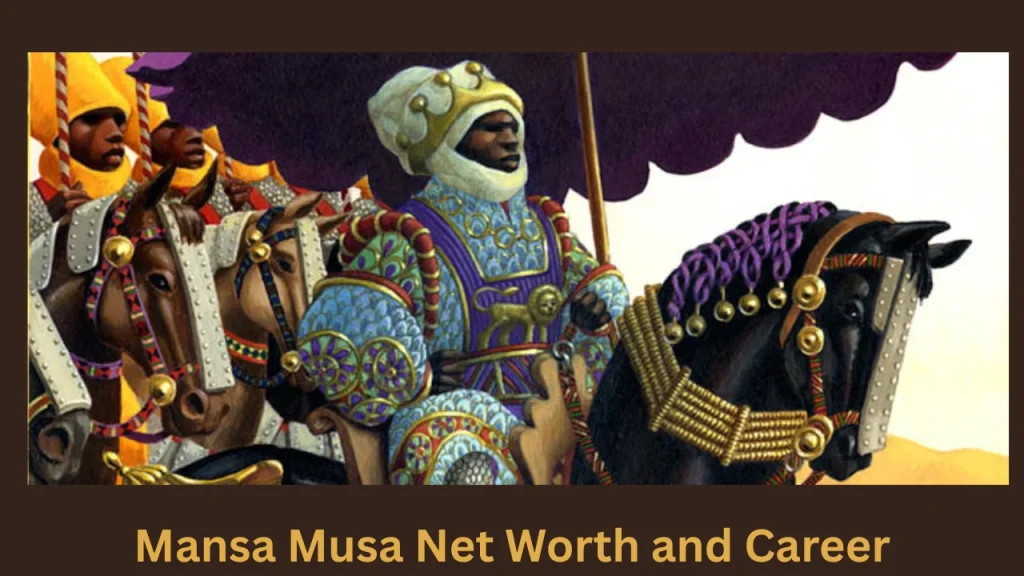When we talk about wealth, modern names like Elon Musk or Jeff Bezos usually come to mind. However, one historical figure eclipses them all: Mansa Musa. Known as the richest person to have ever lived, his fortune is nearly impossible to measure in today’s terms. In this article, we explore Mansa Musa net worth, diving into his life, rise to power, family, and legacy.
Who is Mansa Musa?
Mansa Musa, also known as Musa I of Mali, was the emperor of the Mali Empire during the 14th century. He reigned from 1312 to 1337 and expanded his empire to become one of the largest in African history. Mansa Musa was not only known for his wealth but also for his generosity, intelligence, and contributions to education and religion. His most famous journey was his 1324 pilgrimage to Mecca, which revealed the full extent of his enormous wealth to the world.
ALSO READ: Dr Nicole Saphier Net Worth, Age, Weight, Family, Bio 2025
| Full Name | Mansa Musa Keita I |
|---|---|
| Known As | Mansa Musa |
| Date of Birth | Circa 1280 |
| Place of Birth | Mali Empire (modern-day West Africa) |
| Reign | 1312 – 1337 |
| Title | Emperor of the Mali Empire |
| Religion | Islam |
| Spouse | Inari Kunate |
| Dynasty | Keita Dynasty |
| Famous For | Legendary wealth, 1324 Hajj, expanding Mali |
| Estimated Net Worth | Over $400 billion (modern USD estimate) |
| Legacy | Built Timbuktu, promoted education & religion |
| Date of Death | Circa 1337 |
Early Life
Mansa Musa was born around 1280 in the Mali Empire, in what is now West Africa. Though exact records of his early life are scarce, historians believe he was part of the royal family. His rise to power was somewhat unexpected—he was appointed deputy to the previous ruler, Mansa Abu Bakr II, who left on an expedition and never returned. Mansa Musa stepped into leadership and quickly became one of the most powerful rulers in African history.
His early exposure to royal customs, governance, and the Islamic faith played a crucial role in shaping his future rule. Even in his youth, he demonstrated wisdom beyond his years.
Education
Mansa Musa net worth, was a devoted Muslim, and his religious beliefs deeply influenced his approach to education. Under his rule, Timbuktu became a major center of learning in Africa. He funded the construction of schools, libraries, and mosques. He invited scholars from around the Islamic world to teach in his empire.
Although there is little evidence about his personal academic journey, Mansa Musa valued knowledge. His passion for education helped the Mali Empire become one of the most intellectually advanced regions in the medieval world.
ALSO READ: Judy Garland Net Worth, Age, Height, Weight, Family, Bio/Wiki
Relationship
There is limited information about Mansa Musa’s personal relationships, especially his marriage. However, it is documented that he had a wife named Inari Kunate. As queen, she played a significant role during his reign. Unlike rulers of today, little was recorded about the emotional dynamics of their relationship. Still, Mansa Musa ensured his wife traveled with him on important journeys, including his legendary hajj to Mecca.
His respect for her presence in public events highlights a unique aspect of their relationship for the time. Royal relationships in medieval Africa often involved shared responsibilities, especially in governance and social affairs.
Mansa Musa Net Worth and Career

Mansa Musa net worth career as emperor began when he inherited the throne in 1312. His empire quickly expanded, stretching across modern-day Mali, Senegal, Gambia, Guinea, and Niger. He gained control of vital trade routes that moved gold, salt, ivory, and other valuable goods across the Sahara.
One of his most significant achievements was his 1324 pilgrimage to Mecca. This trip was not just religious—it was a political and economic move that showcased Mali’s wealth to the rest of the world. Mansa Musa traveled with a caravan of over 60,000 people and distributed gold generously along the way. His generosity caused inflation in some regions, a sign of just how wealthy he was.
Under his leadership, the Mali Empire became a beacon of wealth, culture, and education. Mansa Musa also commissioned the building of mosques, including the famous Djinguereber Mosque in Timbuktu.
Family
Mansa Musa belonged to the Keita Dynasty, which had a long-standing lineage of rulers. His family played a central role in the governance of the empire. His brother, Mansa Abu Bakr II, was the ruler before him. Upon his brother’s disappearance, Mansa Musa ascended the throne.
He had children who continued his legacy, although none matched the scale of his reign. The Keita Dynasty remained influential in West Africa even after the decline of the Mali Empire. Mansa Musa net worth, family was central to maintaining Islamic principles and royal traditions in the empire.
Mansa Musa Net Worth
Now let’s get to the big question: What was the Mansa Musa net worth?
Historians and economists struggle to assign a precise number to Mansa Musa net worth. However, estimates suggest it could have been over $400 billion in today’s money. Some even claim his wealth was immeasurable, as he owned massive gold mines and controlled trade across a vast region.
Here’s a breakdown of how Mansa Musa net worth compares:
| Name | Estimated Net Worth (Modern USD) |
|---|---|
| Mansa Musa net worth | $400 billion or more |
| Elon Musk | $200 billion |
| Jeff Bezos | $180 billion |
| Bill Gates | $130 billion |
Mansa Musa net worth was largely based on the gold reserves of Mali. The empire produced almost half of the world’s gold supply during his rule. Since gold was the basis of wealth in the 14th century, his fortune was unmatched.
His economic impact was so great that his hajj journey caused major inflation in cities like Cairo and Medina. People were overwhelmed by the amount of gold he gave away freely.
Even today, experts argue that Mansa Musa net worth cannot truly be compared with modern billionaires because his empire’s wealth was tied to land, people, and resources rather than individual cash flow or investments.
Social Links
Mansa Musa lived in the 14th century, long before social media existed. But if he were alive today, his wealth, generosity, and religious devotion would certainly make him a global influencer. Today, you can find mentions of him across various platforms:
- YouTube documentaries about his wealth and empire
- Instagram fan pages showcasing artwork and history
- Wikipedia entries detailing his biography
- TikTok videos summarizing his pilgrimage and gold giveaways
While these aren’t personal accounts, they reflect the continued public fascination with his life and immense fortune.
Physical Appearance
There are no actual photographs of Mansa Musa, but historical illustrations and descriptions provide clues about his appearance. He was often portrayed in ancient manuscripts wearing lavish robes and a golden crown, holding a scepter or a gold nugget—symbols of his immense wealth and power.
Here’s a general depiction based on ancient artwork:
- Skin Tone: Dark
- Build: Strong and noble
- Clothing: Richly colored robes with gold embroidery
- Crown: Gold, often adorned with jewels
- Accessories: Gold bracelets, rings, and a royal staff
His image on the 1375 Catalan Atlas, a famous European map, portrays him as a confident king seated on a throne with a gold nugget in hand—one of the most iconic images of African royalty.
Conclusion
Mansa Musa was not just a ruler—he was a symbol of wealth, faith, and education. His influence stretched far beyond Mali, leaving a legacy that still captivates the world today. While exact figures are debated, the Mansa Musa net worth is universally considered the largest in recorded history.
His life reminds us that wealth is not just about money. Mansa Musa used his fortune to build schools, mosques, and cities. He promoted knowledge, religion, and culture—values that still inspire us centuries later.












